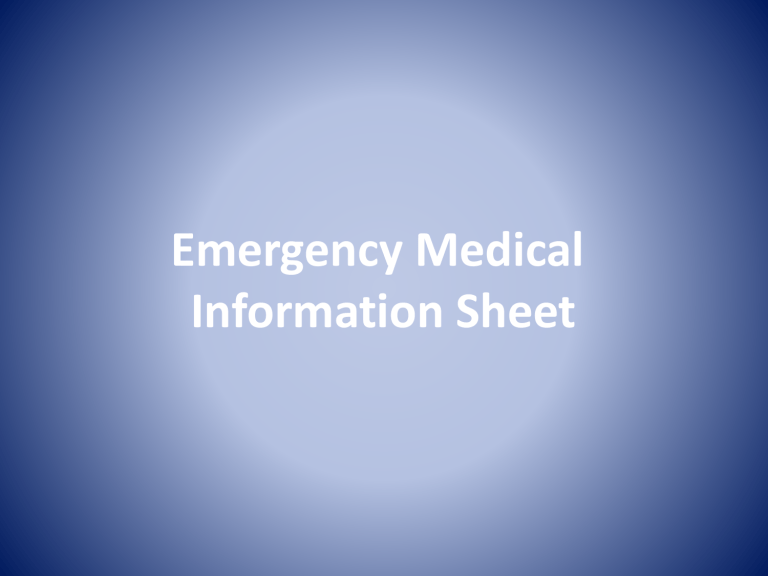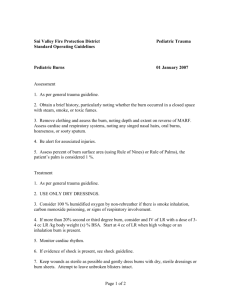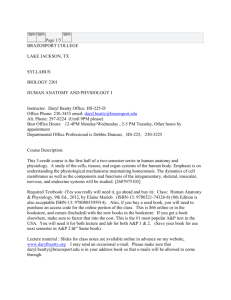Emergency Medical Information Sheet 2012

Emergency Medical
Information Sheet
BRAZORIA COUNTY PETROCHEMICAL COUNCIL /UTMB
Burn / Trauma Training Workshop
Medical Response at Point of Injury: What to Do Before the Calvary Arrives!
In 2011, the Brazoria County Petrochemical Council and The University of Texas
Medical Branch at Galveston held a Burn/ Trauma workshop attended by first responders and medical personnel from throughout the Brazosport area.
Presenters were:
• David N Herndon, M.D.
• John Fraser, Jr, MD, JD, MPH
• Carlos Javier Jimenez, MD
• Jamie Heffernan RN, BSN, CCRN
The biographies and credentials of the above leaders in Burn and Trauma are second to none and the Brazosport area was very fortunate to have this elite group share their expertise, wisdom and insight.
The following Emergency Medical Information Sheet is a product of this workshop.
The goal of this sheet is to provide information that will expedite treatment of industrial patients by giving the responding medical staff a clearer picture of the patient’s condition and extent of injuries that may be unique or unfamiliar due to their industrial origins.
Freeport LNG personnel developed this sheet using input and suggestions from local industry partners including DOW and BASF, local EMS response teams from Freeport and Sweeny, Brazosport College and UTMB Department Heads and their staff.
The following slides will show an example of an Emergency Medical
Information Sheet and an explanation of individual sections.
Information and Personal History
Use these sections to capture as much information as possible about the patient.
The name of the person filling the form and their contact number is important if there are follow up questions from the medical staff.
Time of the Incident can be critical and should be filled in as accurately as possible.
Personal history should be filled in as much as possible.
Chemical Exposure
All items in this section are critical for treatment.
Note: Confined Space checkbox - Medical personnel need to know the severity of chemical exposure through inhalation. This box should be checked if the incident occurred within a confined space even if the main route of exposure is by skin or other.
Electrical Exposure
Electrical incidents may create injuries that are not immediately evident.
High voltage may have traveled through the core of a limb causing internal damage that may not be discovered until it is too late.
The patient may not show the full depth of the injury in time save a limb.
Fall
Harness suspension can create blood clots that may go undetected.
Medical personnel suggestions for this section included adding a line capturing the ground surface. For this version it is assumed the surface was paved or man-made.
Burns
If the Chemical checkbox is marked be sure to fill out the Chemical
Exposure section above.
Note: Severe cryogenic burns have different treatment paths as compared to chemical or thermal burns.
Incident Description and First Aid
These sections allow for a quick overview of the incident.
Describe in short, clear terms the events and details of the injury.
First Aid Given should include any known medications and physical aid given.
Example: Aspirin for suspected heart attack or antihistamines for allergic reactions.
Suggestions are to keep this form in an easily accessible area such as in emergency contact folders or near first aid kits.
Have someone immediately begin filling out the form and have it ready to send with the patient when transport arrives.
Take this form and customize it to suit the needs of your facility, especially if you have the potential for unique circumstances that responders or medical teams may not be familiar with.
Fill out as much of the form as possible in the time you have before transport and send with the patient.
Every moment you save the medical team in assessing a patient is a moment you give to the patient towards the proper treatment path.








